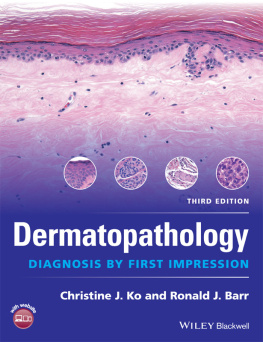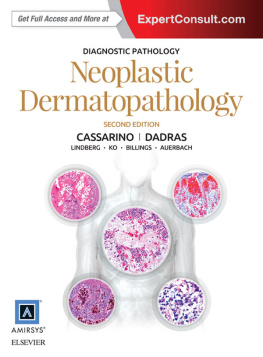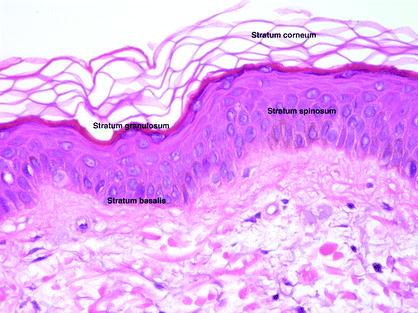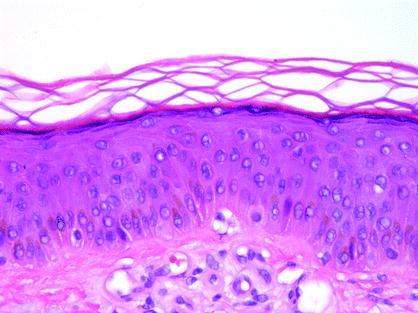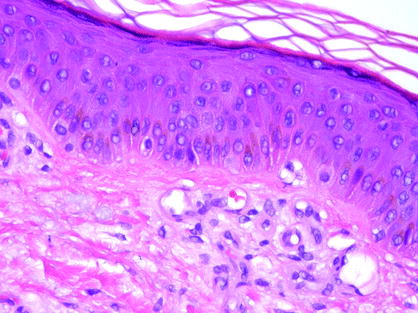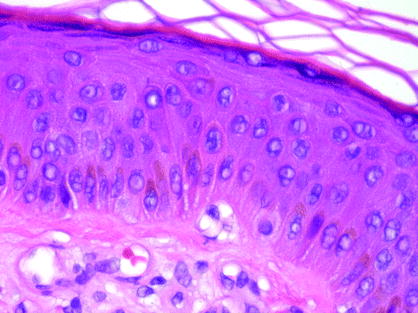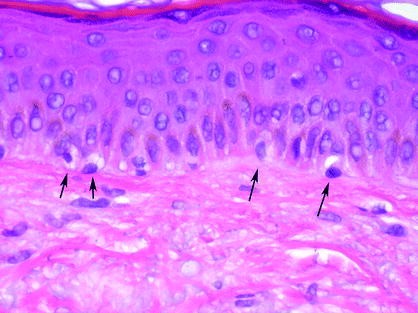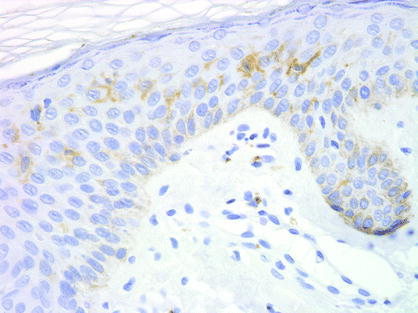Kim M. Hiatt and Bruce R. Smoller Dermatopathology: The Basics 10.1007/978-1-4419-0024-1_1 Springer Science+Business Media, LLC 2009
1. Normal Cutaneous Histology
Bruce R. Smoller 1
(1)
University of Arkansas for Medical Sciences, Little Rock, Arkansas, USA
Bruce R. Smoller Dr (Corresponding author)
Email:
Epidermis varies in thickness with site, but ranges from < 0.1 mm on the eyelids to about 1 mm on acral sitesDermis varies in thickness with site, but ranges from 1 mm on the face to 4 mm (approximately) on the backSubcutaneous fat varies extensively in thickness (up to multiple cm)
1.1 Basic Skin Anatomy
Epidermis varies in thickness with site, but ranges from < 0.1 mm on the eyelids to about 1 mm on acral sites
Dermis varies in thickness with site, but ranges from 1 mm on the face to 4 mm (approximately) on the back
Subcutaneous fat varies extensively in thickness (up to multiple cm)
1.2 Epidermis
1.2.1 Keratinocytes
Epidermis with stratified layers
Stratum corneum
Stratum granulosum
Stratum spinosum
Stratum basalis
Fig. 1.1
Overview of the epidermis demonstrating normal keratinocyte maturation (200)
1.2.1.1 Stratum Corneum
Normal pattern basket-weave orthokeratosis
Nuclei are normally extruded before keratinocytes reach the stratum corneum
Fig. 1.2
The stratum corneum demonstrates basket-weave orthokeratosis (400)
1.2.1.2 Stratum Granulosum
1.2.1.3 Stratum Spinosum
Zone of maturation
Takes basal cell 14 days to reach the stratum corneum and another 14 to desquamate under normal conditions
Nuclear:cytoplasmic ratio becomes progressively smaller in these layers
Keratin production switches from lower molecular weight (cytokeratin 5 and 14) to higher molecular weights (mainly keratins 1 and 10)
Fig. 1.3
The stratum granulosum demonstrates keratinocytes with abundant keratohyaline granules. The spinosum layer keratinocytes have abundant eosinophilic cytoplasm (400)
1.2.1.4 Stratum Basalis
Cells at base of rete ridges are stem cells that proliferate most rapidly
Basal cells at tips of dermal papillae proliferate slowly
Basal cells produce lowest molecular weight keratins (of all keratinocytes) keratins 5 and 14
Fig. 1.4
The basal layer demonstrates pigment-laden keratnocytes and vacuolated melanocytes (600)
1.2.2 Melanocytes
Every tenth cell along basal layer is a melanocyte (on average)
Each melanocyte serves, via dendritic processes, 36 keratinocytes with melanin (on average)
Increased numbers of melanocytes with sun exposure
Produce eumelanin (brown and black) and phaeomelanin (red brown higher in sulfur content)
Transfer melanosomes to lysosomes within keratinocytes via phagocytosis
Individual variation in skin color is a function of relative numbers of stage IIV melanosomes. In general, all individuals have the same numbers of melanocytes (more stage IV in darker skin, more stage I in lighter skin)
Darker races have larger, singly dispersed melanosomes in keratinocytes
Caucasians have melanosome complexes within keratinocytes
Fig. 1.5
Cells with hyperchromatic nuclei and surrounding spaces along the basal layer (arrows) are melanocytes (600)
1.2.3 Langerhans Cells
Mid-epidermal dendritic cells
Constitute 34% of all epidermal cells
Involved in antigen presentation
Bone marrow derived
Express HLA-DR, ATPase, S100, CD1a
Electron microscope demonstrates Birbeck granules, a pentalaminar structure shaped like a tennis racquet when viewed in full longitudinal section
Increased numbers in conditions with increased antigen presentation (i.e., contact dermatitis)
May coalesce into microgranulomata simulating nests of melanocytes
Fig. 1.6
Langerhans cells appear as hyperchromatic nuclei with surrounding spaces in the mid-straum spinosum (600)
Fig. 1.7
CD1a demonstrates the dendritic nature of the intraepidermal Langerhans cells (600)
1.2.4 Merkel Cells
Part of the sensory nervous system
Sit on basement membrane
Have desmosomal contacts with keratinocytes
Haarscheibe one free nerve ending from dermis touches up to 50 Merkel cells to form this unit











